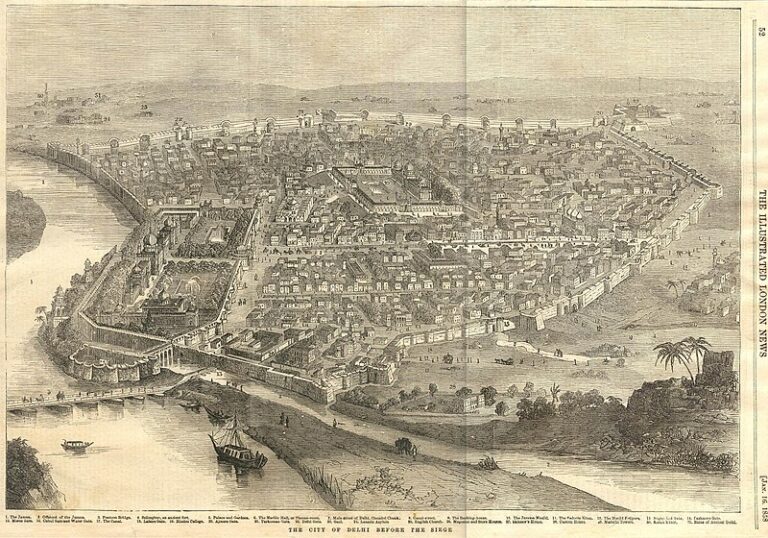Izz-un-Nissa Begum, also known as Akbarabadi Mahal, was the third wife of the Mughal emperor Shah Jahan. The title “Akbarabadi Mahal” suggests she might have come from Akbarabad (present-day Agra). She left her mark on Shahjahanabad (present-day Old Delhi) by commissioning the Akbarabadi Mosque. Less frequently, she is referred to as Sirhindi Begum.
Family- Just for Name
Izz-un-Nissa Begum wasn’t just the wife of an emperor; she came from a distinguished lineage. Her father, Mirza Iraj, held the prestigious title of Shahnawaz Khan. He was the son of the famed Mughal official Abdul Rahim Khan-I-Khana, whose ancestry traced back to Bairam Khan, a descendant of the Black Sheep Turkoman leader Pir-ali Baharlu. Izz-un-Nissa also had a brother named Mirza Khan Manuchir.
Not a Successful Marriage
In 1617, Prince Khurram (later Shah Jahan) celebrated a victory in the Deccan. To solidify his power base, he made some strategic moves. First, he lobbied his father, Emperor Jahangir, to appoint Izz-un-Nissa’s grandfather, the esteemed Abdul Rahim Khan, as governor of the newly captured southern islands. He further secured Shahnawaz Khan, Izz-un-Nissa’s father, as the de facto commander-in-chief of the region, ensuring their loyalty.
Khurram then took the most decisive step: marrying Izz-un-Nissa Begum, Shahnawaz Khan’s young daughter, as his third wife. This political alliance bypassed Emperor Jahangir’s approval, some accounts even suggesting it was forced upon the prince by his ambitions. However, the September 2nd, 1617 ceremony in Burhanpur was a full and official religious marriage.
Izz-un-Nissa Begum’s joy of motherhood was short-lived. Though she delivered a son, Jahan Afroz Mirza, in Agra on June 25th, 1619, the child’s birth wasn’t considered auspicious. Emperor Jahangir, Izz-un-Nissa’s father-in-law, separated the infant from his parents. He entrusted the young prince’s care to his great-grandfather, Abdul Rahim Khan, in the Deccan. Abdul Rahim Khan’s daughter, Janan Begum (widow of the late Prince Daniyal Mirza), accompanied the child
Ironically, according to Jahangir’s own memoirs, Tuzk-e-Jahangiri, a different son’s fate was sealed around this time. In 1621, his son Shah Shuja fell ill with smallpox, and astrologers predicted his demise. However, another astrologer, Jotik Rai, countered with a different prophecy – that a disliked son of Shah Jahan would die instead. Sadly, this prophecy came true for Izz-un-Nissa Begum, as her son Jahan Afroz Mirza passed away prematurely in Burhanpur during March 1621.
While Shah Jahan married Izz-un-Nissa Begum and Kandahari Begum, his heart truly belonged to Mumtaz Mahal. Chroniclers of the time paint a clear picture: Shah Jahan’s affection for Mumtaz Mahal far surpassed his feelings for his other wives. As Inayat Khan phrased it, “his whole delight was centered in this illustrious lady”. According to Qazvini, Izz-un-Nissa and Kandahari Begum “enjoyed nothing more than the title of wifeship”.
However, after Mumtaz Mahal’s death, things shifted. Inayat Khan notes that Izz-un-Nissa Begum, along with another wife, Fatehpuri Mahal, received the emperor’s special favor. This suggests that Izz-un-Nissa’s position within the court may have changed after the loss of Shah Jahan’s beloved wife.
A lonely Death
Outliving her husband Shah Jahan by twelve years, Izz-un-Nissa Begum passed away in Agra on January 28th, 1678. Emperor Shah Jahan, evidently concerned about her well-being, ensured her security even on his deathbed in 1666. Izz-un-Nissa left her mark on Shahjahanabad (present-day Old Delhi) by creating the Sirhindi Garden, where she was ultimately laid to rest. The tomb itself is known as the tomb of Sirhindi Begum, suggesting this may have been another title she held.
Not Much Art on Her Name
In a major southern market of Delhi, she funded the construction of a serai (rest house) and an impressive mosque. This mosque served as Shah Jahan’s place of worship until his own grand mosque was completed in 1656. Unfortunately, the mosque built by Izz-un-Nissa Begum no longer stands. However, 19th-century illustrations suggest it resembled contemporary mosques built by Shah Jahan’s other wives, Fatehpuri Mahal and Jahanara Begum.
Unfortunately, there are no known portraits of Izz-un-Nissa Begum. However, there are images of some of the places she influenced including the city she helped shaped, Shahjahanabad (present-day Old Delhi).

2 thoughts on “Izz-un-Nissa Begum: The Queen of Tragedy”
Very painful story
I am it is quite a tragedy, things shifted for izzu nissa not to much she would get some gifts and money here and there but with no say in poltics,if shah jahan wanted he could get her pregnant once again but he didn’t atleast his first wife khandhari begum had a daughter not the same with izz un nissa.